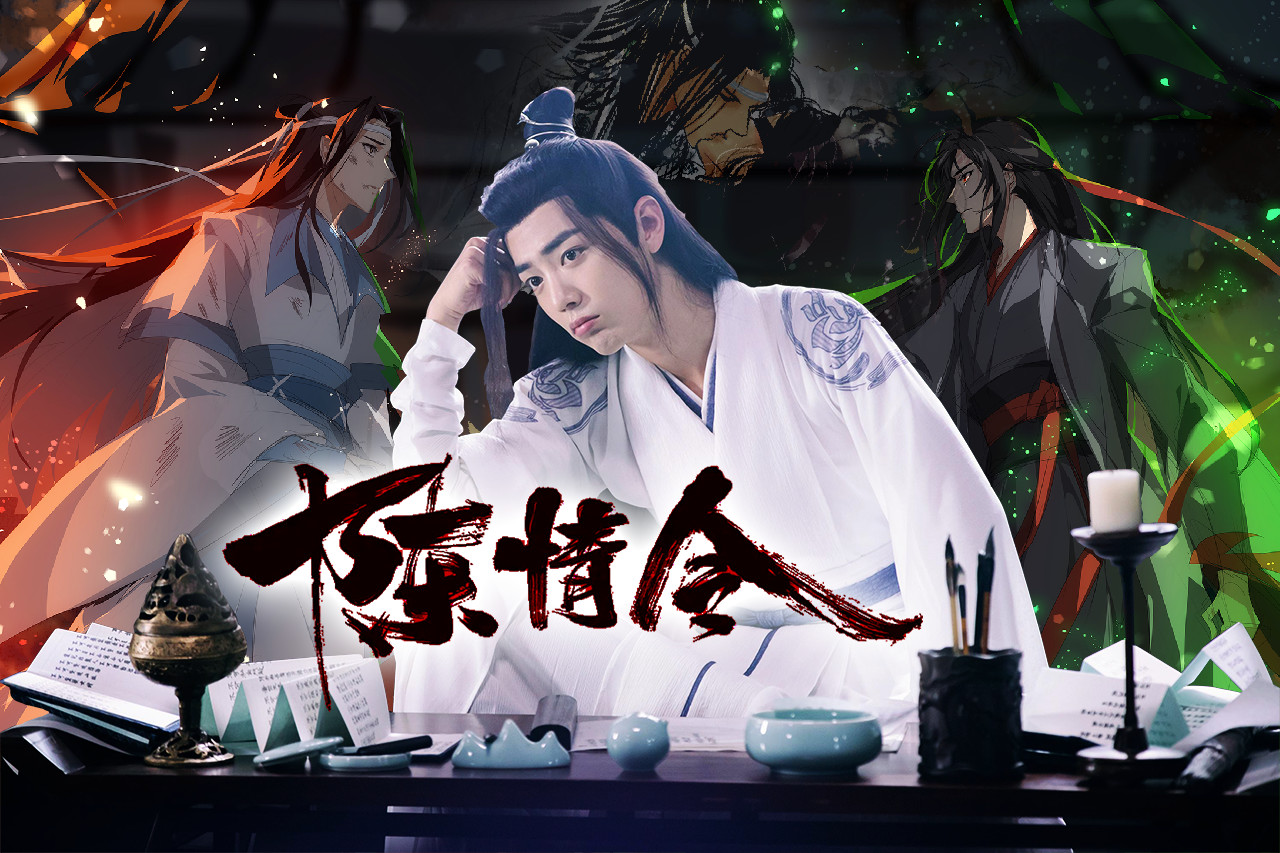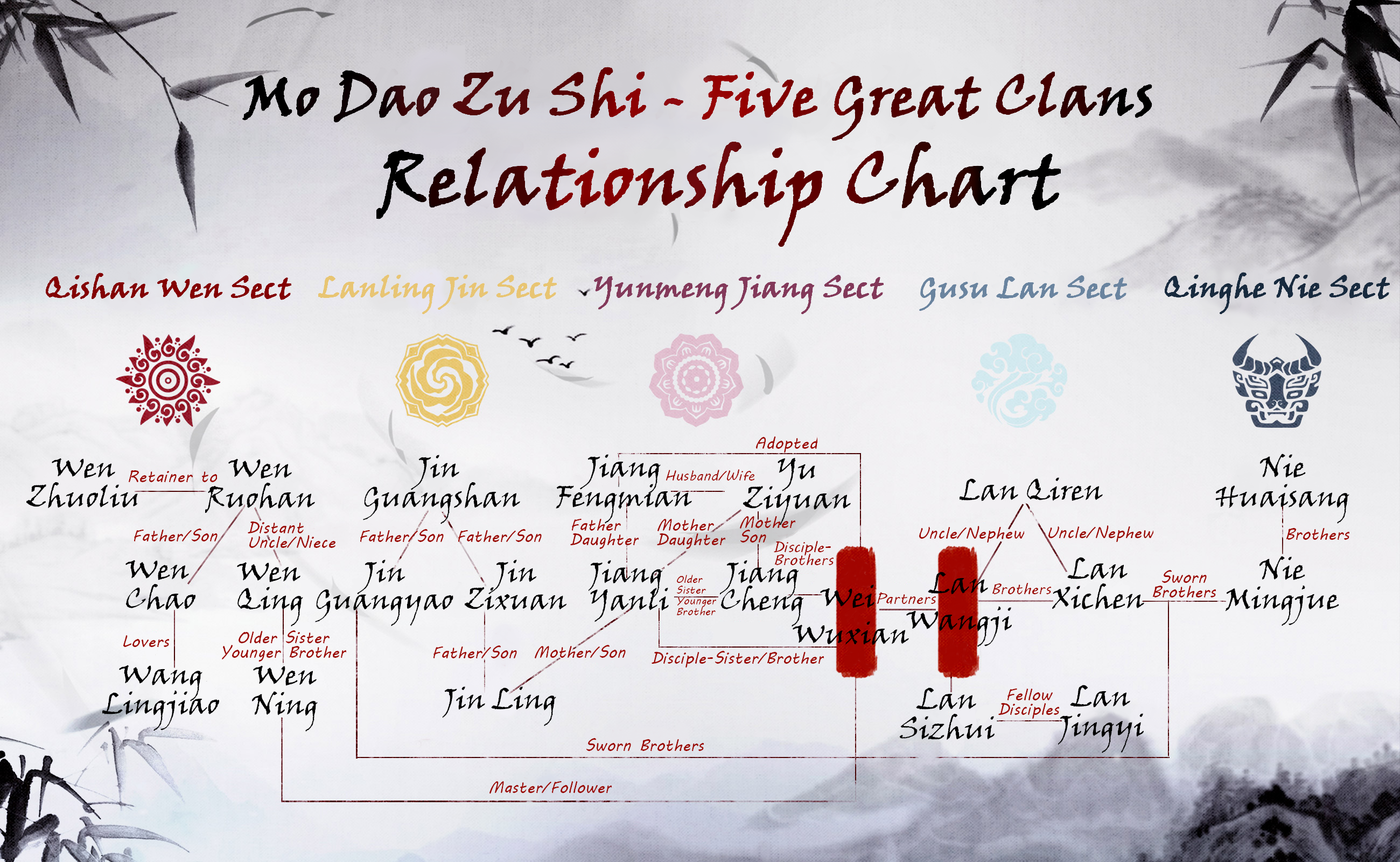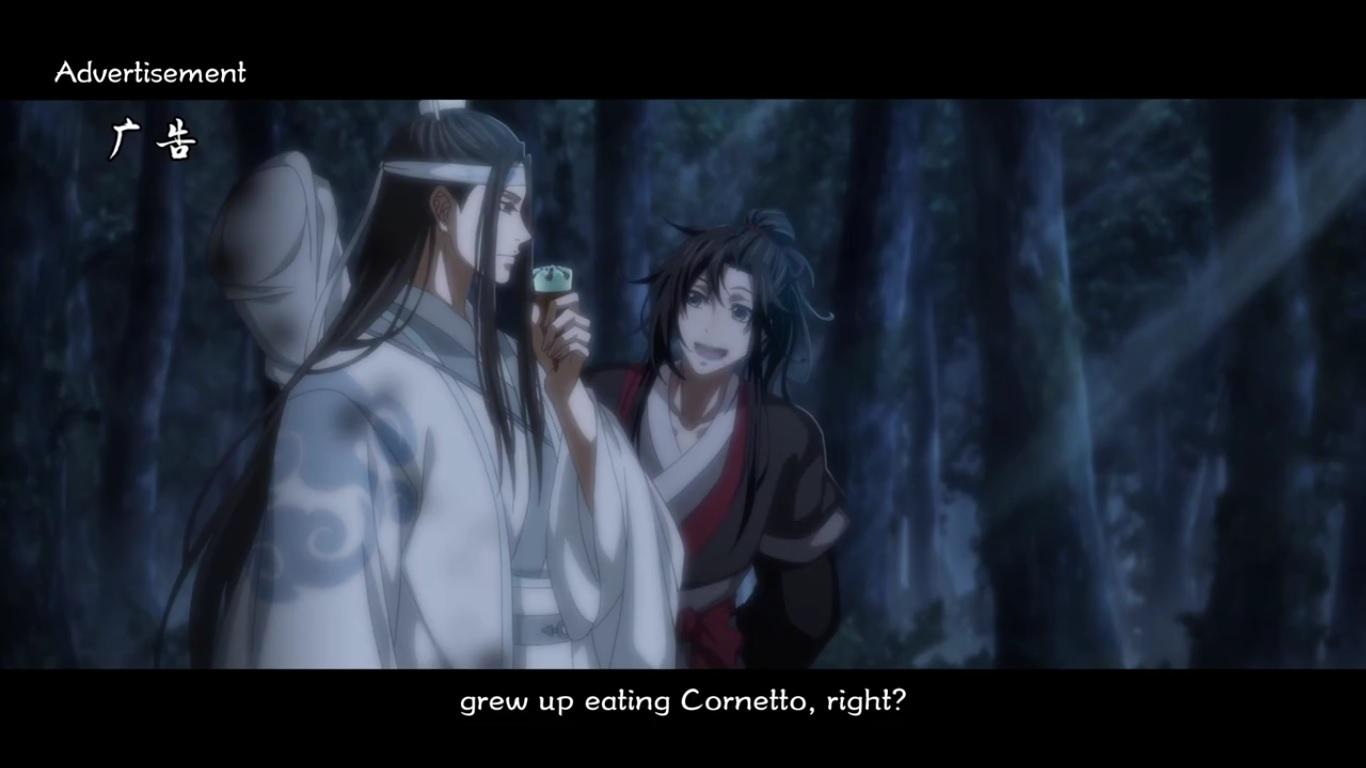
MoDaoZuShi: Expand Donghua
Published 2020-03-10 natively
Animation(1-15) & Live-action(1-20) [rough]
The series that made me question more than my sexuality
Firstly, what in the hell is this? The answer is not immediately clear, depending on your first familiarity, and precipitates further questions. Originally, it is a 'BL' (that is, homoerotic) novel published in high Chinese; interesting in itself. Yet it has since been adapted into an audiobook, audiodrama, manhua (sino-manga), donghua (chiname? chinime?), and even into a live-action drama; the last two of which peaked an interest both intellectual and prurient, enough to deserve attention. While the original content is homoerotic, both were published by Ten$ent, the quasi-state Chinese megacorp; does this reflect the extent of disconcern for social positions within its capitalist apparatus? Both are apparently also being developed and released continuously, along with the manhua; why would you make both an animation and a live-action series over the same narrative? The very existence of such media seems improbable, provocative, yet it is the quality of this content and what it reveals that begs the most severe question: have the Chinese discovered the soul?
The story is largely the same, but the details and execution differ. Therefore it is less like a mirror than two vines climbing towards the same sun. Many points, some dialogue will be identical, but have a dissimilar texture and impact of necessity. Attempting some of the same notes that are successful in animation with real actors and digital effects is chancy, but the unusual expressiveness of those actors and the palpable budget involved make it less jarring than more amateur live-action (as most is). Though tolerable, it remains necessarily and intrinsically artistically inferior, so the question is not so much one of which-is-better, as if each is enjoyable for its particular qualities. The underlying story and characters are both of such an order, and each execution faithful enough to them, that neither attempt will be meritless.
For those without a complex about being weebtrash, or those simply blighted with normalacy, the live version will suffice. For the young and pure-of-soul, the animated one should be attempted first; the story deserves telling in full form, unburdened by corporeal awkwardness. For those with breadth of mind, and precious time, however, there is a virtue to watching the live version aswell, not with an eye for the story again (for that will be inferior), but for the way it is told, and the thoughts it raises. A beautiful painting inspires strong emotions, but a different set than a beautiful face, and any piece which gives emotion and grace to a living form, making it holistically admirable, is remarkable enough.
As a quick note, the following chart may be useful in clarifying the characters and their sometimes-subtle relationships during the main arc:

Beginning with the donghua (which is to be recommended):
From the first, unless one is extensively familiar with the nuances of the genre or has a keen aesthetic discernment, it is difficult to distinguish it from a modern anime. Stylistically, the illustrations in characters and scenery follow heavily after the cultural supremacy of Nipon, and given the fantasy setting the specifics of what is depicted are not immediately apparent. The most notable and most jarring difference is when those characters begin to speak, or sing as in the case of the exquisite op/end segments, and familiar visuals meet distinctly unfamiliar cadences, not the flowing and ordered consonant-vowel pairs of Japanese but the clipped and heavy tonalities of Mandarin. When sung, this is much less obtuse, incorporating itself with the soundtrack's ebb and flow, but it takes some episodes to become accustomed to it in dialogue. However by the end, when one is familiar not only with the general tenor of the language but the particular manner of each of the characters, it is as comfortable as the visuals, and one cannot fault the talent at play striking an balance of emotion and composure that is unfortunately fleeting in anime. Regarding the visuals, equal attention is paid at rest and in its action sequences, which are more interested in aesthetic quality than in stylistic distinction, and make the tranquil scenes of cloudy mountain passes as lively and colorful as those of flashing blades and flourishing spells. It must be noted that some CGI is evident in background scenes, occassionally in panning, but it is no more abrasive or common than in the average modern anime (as little as that may console some), and it seems to become less present as the series progresses. There is no otherwise-beautiful scene, no elegance of gesture or depiction which is marred by laziness or inattention, and many sequences seem composed with a sincere love for its subjects, chiefly its characters, and incorporate actively with the music into a venerable harmony beyond that glimpsed in other sino-media.
Man I love that flute soundtrack. Light, airy and yet clear, each note whistling boldly yet artfully, with no reason to fear attention, bewitching the wistful heart and speaking for worldless dreams. Such an instrument stands upon the mountain and sounds over the world, above all of its bustle and lesser noises, reminding them of something purer than echoes can hold, and it can run as slowly and softly as drifting cloud or as quickly as water falling over stones, bridging earth and sky with a melody that may lilt or keen in proper order. With only delicate accompaniment it takes the breath and spreads it farther and more peacably than any word, shaped by clever fingers into notes more tender than any touch of skin; is there any wonder that it should accompany the most pure of emotions and delicate of loves, for it holds the tenor of all noble things. Enchantment and desire, calm and curiosity spiral after the fading melody, catching in the heart even after the ear has turned, as the unsuspected admiration of a peer whose scorn is sweet and reluctant favor sweeter. The flute alone seems apt for this longing more than physical, which onsets far before the lurid curiosity, and flows on before that unnamed spark catches flame and warms the cheeks.
Suddenly, in the midst of the episode, there is an interruption; strange, why?

Why is that ice-cream blue? Is that desirable to the Chinese? It seems an unwholesome color for dairy, yet despite the blatant nature of the advertisement, I find it persuasive. Why is it blue? Perhaps there is virtue in the blueness. Yet the virtue the ad extols is simplicity, not the blue of exotic strangeness, but the placid blue of food coloring diluted to appropriate concentration. Strange, but simple; a frozen novelty like any I might find here, only blue; I can respect it. The ad itself embodies this simplicity, presenting itself as an advertisement, overt product placement in its own segment, without the trickery of subliminal insertion or tangential allusion. It even declares itself deferentially, 'for your consideration', presenting itself as a prospect for consumption, not a vital necessity or driving aspiration; never in Western advertising have I felt so respected by a brand. Though the product is the same, it is not dyed in the overbearing swagger of capitalist excess, yellow to inspire hunger and greed, but in the calm and distant blue of a more moderate consumerism. Embodied in that stylistically-distinct product is not the dream of sweetness and temporary satiation, but a reasonable mutual satisfaction. While I may still scrub past this ad, I feel no malice towards it, no resentment. For more than any frozen delicacy, barring perhaps lemon sherbert, what I truly desire is to be untroubled by a thousand bustling pitchmen.
Moving on to the live-action drama (which is only contextually recommended):
There is a certain art to old-fashioned coreographed fight scenes and wire acrobatics, which while having an entirely different flow compared to animation is not wholly inferior, and the live version is thankfully inclined towards relying on physical props over digital effects, such that any given fight sequence holds a different dynamic, not merely different look. The violence is muted even beyond this, which can render much of the dramatics of combat and calumny rather listless, and certainly makes it less entertaining. It provokes curiosity as to how much of that is determined by cultural attitudes and those of media censors, and different lines drawn between different mediums; the most simple guess being that the Chinese do not share the particular American obsession with realistic and visceral violence, given the clear lack of interest in mimicking it.
Perhaps the single most significant deviation from the animation, beyond plot points, and the most distasteful, lies in the female roles; in the first season of the animation there are only a handful of named females, but in the live-action females are often used to advance the plot, and are represented studying as men do. The animation, which must hold artistic primacy, makes no such pretense, and in the main cloud monastery arc there are only men (technically boys, by the Chinese ceremony at twenty), shaping evenly one-another's character and forming the bonds which will later drive the story; a vision of heaven. While the series makes a compelling case for the ability of Chinese men to possess a soul of nobility and sensibility, it is impossible to seriously believe the same about Chinese women, particularly when one must look at them. At best, they are impassive, porcelain dolls which ornament a scene; at worst, they are as ungainly and akward as women in any western drama. In a story centered around the relations of comely and learned youths, there is no need for the dulled sexuality women embody, and thus no need for women at all. Given the setting; no men have ever studied high arts in the presence of women or permitted their intrusion, it is difficult to view this as anything but a liberty, a degredation of casting and perhaps of pandering to the broad and uncritical mass that surely brims over the watching audience of that tightly-clustered nation of billions.
It is also significantly stretched-out; taking twenty fourty-minute episodes compared to fifteen twenty-minute ones, while any given episode is not filler (barring ep16, which can be skipped altogether), the natural pacing lingers and makes some sequences unnecessarily long. Initially tolerable, as the episodes drag on, it dilutes its enjoyable qualities to a degree approaching tedium, without the uncertainty and anticipation which so much drama relies upon to coast. In short it is the second face of drama which begins to wear through its polished appearance: repetition, hysteria, reaction shots, flash-backs and worst of all, the presence of women. A small set of characters, however handsome in development, become irksome in inaction and dissolution, suffering under ill fate without the tension in manly virtues which reverses fate, revenges injustice, but in the womanly lassitude and regret, and there is nothing enjoyable about something pathetic. No face is pretty enough to admire pouting, and those of stronger spirit, chiefly the protagonist, are only drug down in indulging that of others. It is surely a tragic story, the miserable chapter necessary in any heroic epic, but one cannot help but pine for Wuxian's irrepressible smile and Wangji's unshakeable dignity, that beauteous duality at the center of the story. I made it to ep18 before hitting 1.5x.
The ultimate conclusion is that however beautiful the asian face, it restricts the eyes, and no matter if they reclaim some soul from their ancient myths, it will never shine through them. We may respect and honor the best among our neighbhors, as fully as our own, and rank together with them in the grand orders inheriting this world. But our highest love we must reserve for our own sort, who still hold the highest aspects of nature and civilization, and are often forgotten in our modern darkness. Should we need to look at strange faces and ancient manners to remind us what is good and noble, this fable shall serve.
HH.
[Index]